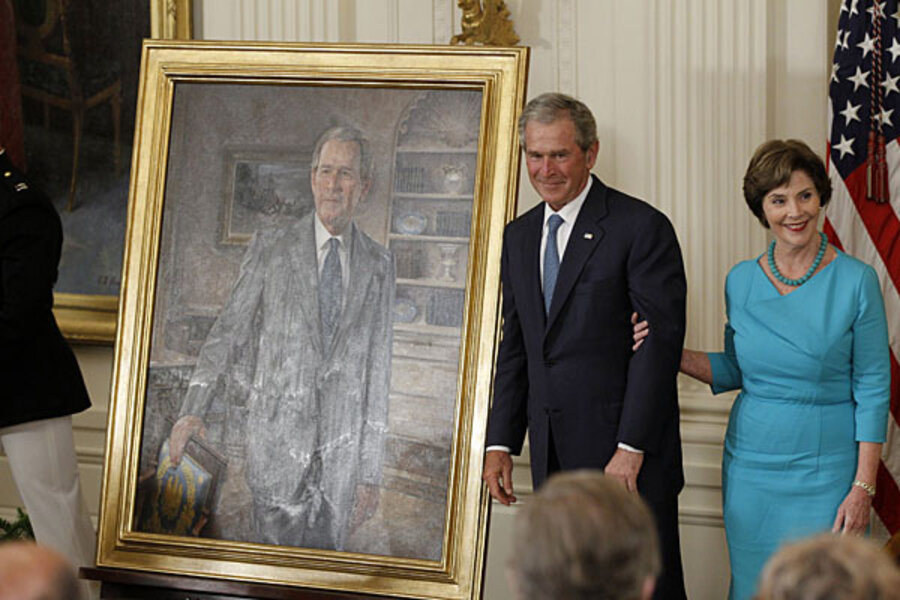George W. Bush presidential portrait is unveiled. Who paid for it?
Loading...
President Obama welcomed his predecessor back to the White House on Thursday for the unveiling of the official George W. Bush and Laura Bush portraits. As we watched the two men interact graciously during the event, we could not help but wonder: Where did it come from?
Not the amity. Obama and Bush are members of the presidents’ club and have more in common with each other than with the leaders of their respective parties. We mean the picture itself. Who chooses the artists for official presidential portraits, and how? Who pays for the painting – taxpayers, private citizens, or presidents themselves?
Well, presidents choose their own painters. But it’s not an easy process. Sometimes things don’t work out – Lyndon B. Johnson picked a second artist after the first produced a painting he thought “ugly” in all ways. And there are many applicants. Portfolios flood into the White House from artists, their agents, galleries, staff members, friends, and family.
During the Clinton administration, Hillary Rodham Clinton reviewed these submissions. The first lady sought advice from the White House curator and the director of the National Portrait Gallery, according to an article by White House curator emeritus Betty C. Monkman in the journal White House History.
After Clinton won reelection, Mrs. Clinton began interviewing artists, sometimes with the president in tow. Just before leaving office Bill Clinton picked the Alabama-born Simmie Knox to produce his official likeness. After seeing the likeness – which depicts a rather formal Clinton standing in the Oval Office – Mrs. Clinton picked Knox for her official first lady portrait as well.
Taxpayers don’t foot the bill for this art. At least, not all taxpayers do. They’re paid for via private donations channeled through the nonprofit White House Historical Association.
“We have for years been underwriting the cost of official presidential portraits,” says Maria Downs, WHCA director of public affairs.
This is a fairly recent phenomenon. Prior to the historical association’s founding in 1961, there was no organized effort to produce a line of presidential and first lady portraits for the White House itself. Well into the twentieth century the commission of official portraits was a “haphazard affair,” according to former curator Ms. Monkman.
In 1800, for instance, Congress allocated $700 to purchase a portrait of the recently deceased George Washington. This paid for what has since become one of the icons of American art, indeed one of the touchstones of American history – the full-length “Lansdowne” portrait by Gilbert Stuart.
Four years after Abraham Lincoln’s death, Congress allocated funds for a Lincoln portrait competition. President Ulysses S. Grant picked the winner: a full-length portrait by Chicago artist William Cogswell. Ironically, today a losing effort from that contest is better known. It’s the famous portrait of a brooding, sitting Lincoln, produced by another Chicago painter, George P.A. Healey. Bought by Lincoln’s son Robert Todd, it eventually ended up back in the White House. Today it hangs in the State Dining Room.
Other notable official portraits include John Singer Sargent’s rendering of Theodore Roosevelt, who appears thrumming with energy, ready to bust from the stairway where he is standing, and Aaron Shikler’s posthumous painting of John F. Kennedy, his eyes downcast, against a gray background that makes him appear almost a ghost.
Presidential paintings hang at the National Portrait Gallery, and in individual presidential libraries, but it is particularly fitting that the White House itself should have the official collection, writes William Seale, editor of White House History.
“Portraits of [presidents] seem to belong there, making windows into that long history,” he writes.








